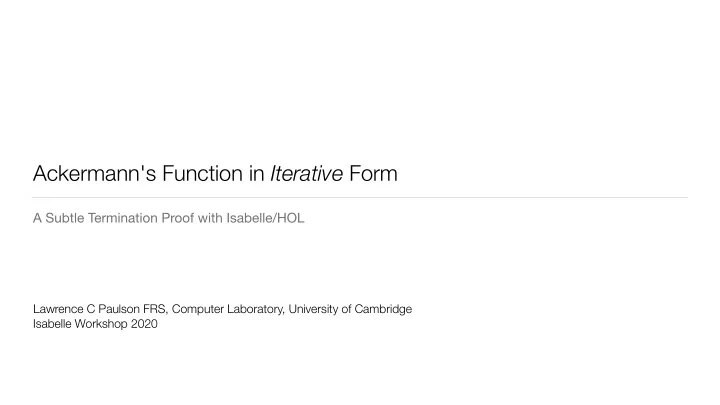

Ackermann's Function in Iterative Form A Subtle Termination Proof with Isabelle/HOL Lawrence C Paulson FRS, Computer Laboratory, University of Cambridge Isabelle Workshop 2020
I. A Brief History of Ackermann’s Function
Wilhelm Ackermann’s “generalised exponential” (1928)
Rózsa Péter’s 2-argument function (1935)
Raphael Robinson’s refinement (1948)
Basic facts about Ackermann’s function, ϕ m ( n ) • Its purpose was always to exhibit a computable function wasn’t “recursive”. • what we now call primitive recursive (PR) • if f is PR, then there exists m where is a strict upper bound for f ϕ m ϕ 4 (3) = 2 2 65536 − 3 • It generates huge numbers: • Expressing it in most formal models of computation is difficult.
II. Ackermann’s Function using a Stack
Ackermann’s function in Isabelle the recursive version that we all know and love
A stack-oriented version as a term rewriting system • The box constrains rewriting to the head of the list • A stack represents a nest of calls: ack( k n , ack( k n − 1,…, k 1 )) • Does it terminate? No term rewriting termination checker knows!
A stack-oriented computation of ack(2,3) ack(1,7) 3 2 ack(2,2) = 7 = ack(1,ack(2,2)) 2 2 1 7 1 1 2 1 1 ack(1,ack(1,5)) 6 1 0 0 2 1 1 1 5 1 0 0 5 1 1 1 1 1 1 1 4 1 0 0 0 4 1 0 1 0 1 0 1 1 1 3 1 0 0 0 0 3 1 0 0 1 1 0 0 1 1 1 2 1 0 0 0 0 0 2 1 0 0 0 1 2 0 1 1 1 1 1 0 0 0 0 0 0 1 1 0 0 0 0 1 3 1 1 1 0 1 0 0 0 0 0 0 0 0 1 0 0 0 0 0 1 2 1 0 1 1 1 0 0 0 0 0 0 0 0 1 0 0 0 0 0 0 1 1 1 0 0 1 1 2 0 0 0 0 0 0 0 2 0 0 0 0 0 1 0 1 0 0 0 1 1 3 0 0 0 0 0 0 3 0 0 0 0 1 1 0 0 0 0 1 1 4 0 0 0 0 0 4 0 0 0 1 2 0 0 0 1 1 5 0 0 0 0 5 0 0 1 3 0 0 1 1 6 0 0 0 6 0 1 4 0 1 1 7 0 0 8 0 what is the ordering here?? 9
Defining a recursive function without a proof of termination • All recursion calls hold conditionally : only if the domain predicate holds • Our task is to prove that the domain predicate is always true
III. Verifying Ackermann’s Function in Isabelle/HOL
Built-in properties of the domain predicate • It terminates for empty and single-element lists. • It terminates for some longer lists. • Does it terminate for all lists?
Proving termination in all cases: by induction on ack m n this implies termination for a longer list beginning with n and m The base case is ack 0 n # L which reduces to Suc n # L , and we have (by definition)
Continuing the induction on ack m n The case ack (Suc m) 0 # L reduces to ack m 1 # L We have the induction hypothesis then (by definition) The case ack (Suc m) (Suc n) # L is similar, but needs 2 induction hyps
The entire inductive proof is a one-liner! It’s fully automatic, using the special Ackermann induction rule
An auxiliary function to complete the proof • This formalises how the list represents k 1 , …, k n ack( k n , ack( k n − 1,…, k 1 )) • … and its induction rule is just right, case-splitting on whether . n < 2
Terminating the termination argument Another one-liner using a special induction and our lemma Finally, Isabelle recognises our function as total!
Concluding the proof: Ackermann can be computed iteratively Equivalence between the term rewriting system and direct calls to Ackermann’s function
Concluding remarks • The verification of the iterative Ackermann function is easy in Isabelle/HOL • … yet the termination of the term rewriting system is an open question! • Implementations of Ackermann's function in > 200 different languages are available online: https://rosettacode.org/wiki/Ackermann_function Funded by ERC Advanced Grant ALEXANDRIA (Project GA 742178). René Thiemann investigated the rewrite systems.
Recommend
More recommend